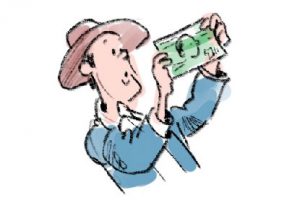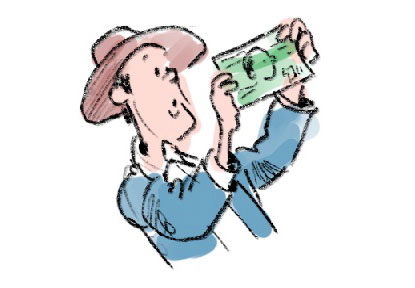What’s the world’s most consumed food? Name the world’s first fully solar-powered airport? These and more are in our latest trivia game.
Global Trivia 4
You have multiple choices. An explanation and a reference comes after every question. There is no fixed order so you can choose from any of the boxes. The SHADED BOXES are what you already answered. Your final score is at the END. Don't hit REFRESH unless you want to start all over. This is part of a continuing series in Traveling Boy.
Start
Congratulations!
You have completed Global Trivia 4.

You scored %%SCORE%% out of a possible 5 points.
Your performance was: %%RATING%%
Your answers are highlighted below.
Question 1 |

What nation invented paper money?
A | China |
B | Germany |
C | Great Britain |
D | India |
E | Japan |
Question 1 :
A. China
First paper, then paper money. This is pure logic. It is hardly surprising that the first notes or better, the first paper money, appeared in China. With the invention of paper and printing on its account, this country was almost destined to produce the first paper money.
For centuries the mulberry tree has been cultivated in the Valley of the Yellow River (Shang period, 18th to 12th century BC). The first traces of paper date back to the 2nd half of the 1st century BC but then it was not used as writing material. For their traditional calligraphy with brushes they used linen, hemp, bamboo (cane) and bark of the mulberry tree. Important progress has been made between the 2nd and 4th century AD: Thanks to the use of soaked bast of the mulberry the quality of the pulp significantly improved and paper became less heavy. The improvement was such that paper gradually replaced the former bamboomats. Clerical texts and reports for the Court were henceforth written on paper but still in a vertical direction. This centuries-old way of writing is probably a result of writing on strips of bamboo which were tied together.
During the Tang Dynasty (618-907) there was a growing need of metallic currency, but thanks to the familiarity with the idea of credit the Chinese were ready to accept pieces of paper or paper drafts. This practice is derived from the credit notes used by merchants for their long-distance trade.
— Museum of the National Bank of Belgium
First paper, then paper money. This is pure logic. It is hardly surprising that the first notes or better, the first paper money, appeared in China. With the invention of paper and printing on its account, this country was almost destined to produce the first paper money.
For centuries the mulberry tree has been cultivated in the Valley of the Yellow River (Shang period, 18th to 12th century BC). The first traces of paper date back to the 2nd half of the 1st century BC but then it was not used as writing material. For their traditional calligraphy with brushes they used linen, hemp, bamboo (cane) and bark of the mulberry tree. Important progress has been made between the 2nd and 4th century AD: Thanks to the use of soaked bast of the mulberry the quality of the pulp significantly improved and paper became less heavy. The improvement was such that paper gradually replaced the former bamboomats. Clerical texts and reports for the Court were henceforth written on paper but still in a vertical direction. This centuries-old way of writing is probably a result of writing on strips of bamboo which were tied together.
During the Tang Dynasty (618-907) there was a growing need of metallic currency, but thanks to the familiarity with the idea of credit the Chinese were ready to accept pieces of paper or paper drafts. This practice is derived from the credit notes used by merchants for their long-distance trade.
— Museum of the National Bank of Belgium
Question 2 |

What is the world’s most consumed staple food?
A | Cassava |
B | Corn |
C | Potatoes |
D | Rice |
E | Wheat |
Question 2 :
B. Corn
Indigenous populations in present-day Mexico first domesticated corn around 10,000 years ago. Its long history there explains why it continues to be a staple food today. Nearly every typical Mexican dish revolves around corn in some way, and it is the main ingredient in maize tortillas, for example. With international trade, corn has been spread throughout the world and now makes up a major source of food in Africa, Europe, and the US. People boil and eat it whole, dry and pulverize it to make flour, and cook it in sweetened milk for dessert. It can be processed for other uses that include as ingredients in sweeteners (corn syrup), alcohol (whiskey), and cooking oil. Globally, humans get 19.5% of their calorie intake from corn.
Indigenous populations in present-day Mexico first domesticated corn around 10,000 years ago. Its long history there explains why it continues to be a staple food today. Nearly every typical Mexican dish revolves around corn in some way, and it is the main ingredient in maize tortillas, for example. With international trade, corn has been spread throughout the world and now makes up a major source of food in Africa, Europe, and the US. People boil and eat it whole, dry and pulverize it to make flour, and cook it in sweetened milk for dessert. It can be processed for other uses that include as ingredients in sweeteners (corn syrup), alcohol (whiskey), and cooking oil. Globally, humans get 19.5% of their calorie intake from corn.
| Rank | Staple Food | Share of Global Caloric Intake From All Sources |
| 1 | Maize Corn | 19.5% |
| 2 | Rice | 16.5% |
| 3 | Wheat | 15% |
| 4 | Cassava | 2.6% |
| 5 | Soybeans | 2.1% |
| 6 | Potatoes | 1.7% |
Question 3 |

What industrialized nation has the highest income inequality?
A | China |
B | Russia |
C | Saudi Arabia |
D | Thailand |
E | USA |
Question 3 :
D. Thailand
According to the Credit Suisse report, the bottom 10% of Thais hold 0% of the wealth, being either in debt or having no documented household income. The poorest 50% of Thais now hold only 1.7% of the country’s wealth, while the richest 10% now hold a massive 85.7%.
According to the Credit Suisse report, the bottom 10% of Thais hold 0% of the wealth, being either in debt or having no documented household income. The poorest 50% of Thais now hold only 1.7% of the country’s wealth, while the richest 10% now hold a massive 85.7%.
Question 4 |

What nation produces the most olive oil?
A | Greece |
B | Italy |
C | Portugal |
D | Spain |
E | Turkey |
Question 4 :
D. Spain
Spain produces 5,276,899 metric tons of olive annually. Production of olive in Spain is mainly concentrated around the Andalucian region where about 75% of the total olive production in Spain is obtained. Major production provinces in this region are Jaén and Córdoba. The main varieties produced in the Andalucian region are Hojiblanca, Picudo, Picual, Lechin, and Verdial. About 14% of Spain’s olive production is done in the Castilla-La Mancha region which produces the Cornicabra variety of olive. Other olive producing regions are Extremadura, Catalonia, and Valencia. Olive oil is extracted from olives, and it is widely used for cooking purposes such as frying, baking and steaming in Spain. Spain’s main international olive markets are in the US, UK and France.
— WorldAtlas
Spain produces 5,276,899 metric tons of olive annually. Production of olive in Spain is mainly concentrated around the Andalucian region where about 75% of the total olive production in Spain is obtained. Major production provinces in this region are Jaén and Córdoba. The main varieties produced in the Andalucian region are Hojiblanca, Picudo, Picual, Lechin, and Verdial. About 14% of Spain’s olive production is done in the Castilla-La Mancha region which produces the Cornicabra variety of olive. Other olive producing regions are Extremadura, Catalonia, and Valencia. Olive oil is extracted from olives, and it is widely used for cooking purposes such as frying, baking and steaming in Spain. Spain’s main international olive markets are in the US, UK and France.
| 1 | Spain | 5,276,899 |
| 2 | Italy | 3,220,674 |
| 3 | Greece | 2,232,412 |
| 4 | Turkey | 1,292,072 |
| 5 | Tunisia | 841,524 |
— WorldAtlas
Question 5 |

Name the world's first fully solar-powered airport
A | Cochin International Airport, India |
B | Incheon International Airport, South Korea |
C | Kansai International Airport, Japan |
D | Marrakech Menara Airport, Morocco |
E | Winnipeg International Airport, Canada |
Question 5 :
A. Cochin International Airport, India
Teen climate activist Greta Thunberg has drawn attention to the greenhouse gas emissions caused by air travel. In Sweden, she is credited for the spread of “flygskam”– flight shame – which reports say may have encouraged some Swedes to avoid traveling by plane. Perhaps she had never heard of Cochin International Airport. In 2015, it became the world's first airport to operate completely on solar power. The airport is located in Kochi, within the Indian state of Kerala. The airport serves approximately 10 million passengers annually, with more than 1,000 flights departing each week. Additionally, nearly 30 airlines fly in and out of Cochin International Airport, and it ranks as India's fourth busiest airport in terms of international traffic. The airport also features several restaurants and shops, all of which run on solar energy. In 2015, Cochin International Airport became the world's first airport to operate completely on solar power. The airport is located in Kochi, within the Indian state of Kerala. The airport serves approximately 10 million passengers annually, with more than 1,000 flights departing each week. Additionally, nearly 30 airlines fly in and out of Cochin International Airport, and it ranks as India's fourth busiest airport in terms of international traffic. The airport also features several restaurants and shops, all of which run on solar energy.
The use of solar power in Cochin International Airport began in 2013, initially as a test pilot that included the installation of 400 solar panels. Following the success of the test pilot, the airport dedicated 45 acres of land, which had been reserved for cargo handling, to the creation of a solar power plant, and installed a total of 46,000 solar panels. The airport generates 12 megawatts of power, which meets its own use of electricity needs, and any surplus is added to the state grid. The solar plant is anticipated to eliminate approximately 300,000 metric tons of carbon, which is equivalent to planting about 3 million trees.
Teen climate activist Greta Thunberg has drawn attention to the greenhouse gas emissions caused by air travel. In Sweden, she is credited for the spread of “flygskam”– flight shame – which reports say may have encouraged some Swedes to avoid traveling by plane. Perhaps she had never heard of Cochin International Airport. In 2015, it became the world's first airport to operate completely on solar power. The airport is located in Kochi, within the Indian state of Kerala. The airport serves approximately 10 million passengers annually, with more than 1,000 flights departing each week. Additionally, nearly 30 airlines fly in and out of Cochin International Airport, and it ranks as India's fourth busiest airport in terms of international traffic. The airport also features several restaurants and shops, all of which run on solar energy. In 2015, Cochin International Airport became the world's first airport to operate completely on solar power. The airport is located in Kochi, within the Indian state of Kerala. The airport serves approximately 10 million passengers annually, with more than 1,000 flights departing each week. Additionally, nearly 30 airlines fly in and out of Cochin International Airport, and it ranks as India's fourth busiest airport in terms of international traffic. The airport also features several restaurants and shops, all of which run on solar energy.
The use of solar power in Cochin International Airport began in 2013, initially as a test pilot that included the installation of 400 solar panels. Following the success of the test pilot, the airport dedicated 45 acres of land, which had been reserved for cargo handling, to the creation of a solar power plant, and installed a total of 46,000 solar panels. The airport generates 12 megawatts of power, which meets its own use of electricity needs, and any surplus is added to the state grid. The solar plant is anticipated to eliminate approximately 300,000 metric tons of carbon, which is equivalent to planting about 3 million trees.
Once you are finished, click the button below. Any items you have not completed will be marked incorrect.
Get Results
There are 5 questions to complete.
You have completed
questions
question
Your score is
Correct
Wrong
Partial-Credit
You have not finished your quiz. If you leave this page, your progress will be lost.
Correct Answer
You Selected
Not Attempted
Final Score on Quiz
Attempted Questions Correct
Attempted Questions Wrong
Questions Not Attempted
Total Questions on Quiz
Question Details
Results
Date
Score
Hint
Time allowed
minutes
seconds
Time used
Answer Choice(s) Selected
Question Text
All done
Deplorable! You need to travel more! This is pathetic!
Deplorable! You need to travel more! This is pathetic!
Embarrassing! Keep trying! We know you're better than that. Play the game again.
Not that bad! But not good either. Play the game again.
Pretty good ... but not perfect.
Perfect! Are you brilliant traveler or what?

